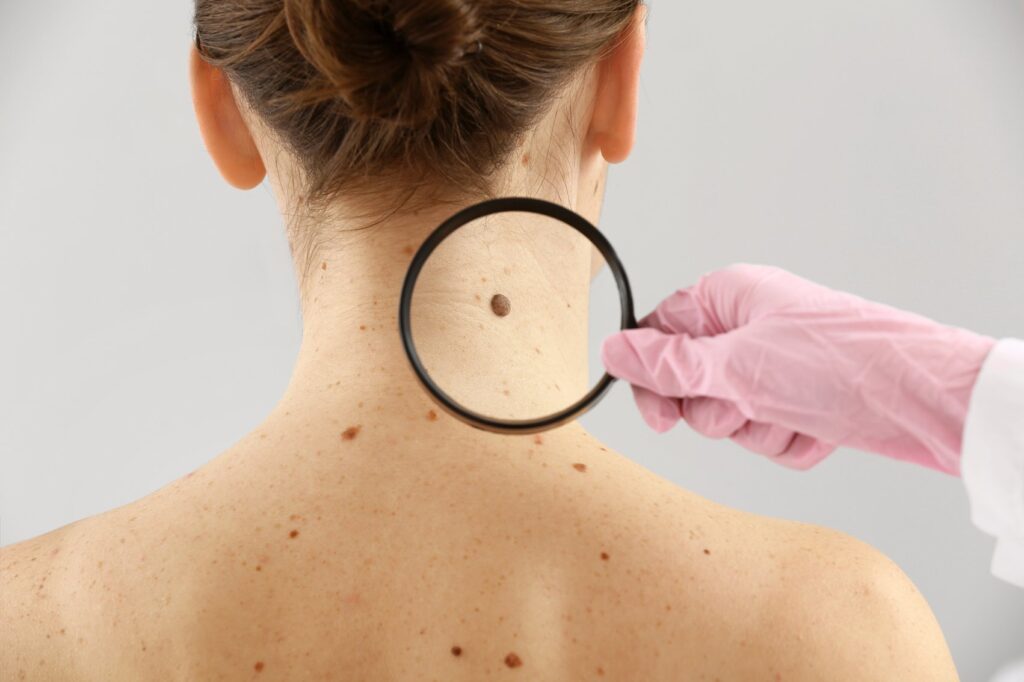Skin Lesions
Have you ever glanced at your skin and noticed that you have a mole, wart or other skin lesions? It’s a common occurrence, and many people freak out.
But, we’re here to tell you not to worry. Many skin lesions are harmless. Getting your skin lesion checked out by a doctor or dermatologist will help you find the perfect treatment option for your skin lesion.
What are moles?
Moles are harmless growths that can appear anywhere on the body. Most often, moles are discovered as small, dark spots; however, they can come in various colors, shapes and sizes.
And, by the age of 50, many people will have developed between 10 to 40 moles. Cancerous moles do appear and can vary in appearance. Some may have all of the characteristics mentioned above or not.

What causes moles to appear?
Moles form when skin cells grow in groups. The brown color of a mole can be contributed to melanin, a natural pigment, being produced.
While most moles are harmless, some things can complicate a mole, such as melanoma and an individual’s risk of developing it, including:
- Being born with congenital nevi: This is classified as a large mole.
- Having moles that look irregular: This could be the shape or color.
- Having a large number of moles: If an individual has more than 50 moles, they could be at an increased risk for melanoma.
- Having a family history of melanoma: Those who have had or have family members who have had melanoma are at an increased risk of developing a cancerous mole.
Preventing the development of moles & melanoma
There are many actionable steps you can take to prevent the growth of moles and melanoma.
- Watch for changes in your mole: It is normal for a mole to grow and change. If a mole is growing quickly or looks different than others, these may be signs of melanoma. We recommend performing self-exams at least once a month and speaking with a dermatologist if you have a family history of melanoma.
- Protect your skin: Take the necessary precautions to protect your skin from harmful rays.
- Avoid peak sun times: To further protect yourself from the sun’s rays, we recommend scheduling outdoor excursions before 10:00am and after 4:00pm as the sun’s rays are strongest between those times.
- Use sunscreen year-round: Apply sunscreen about 30 minutes before going outdoors, even when it’s cloudy. Use a broad-spectrum sunscreen with an SPF of at least 15. Apply it generously and reapply every two hours — or more often if you’re swimming or sweating. The American Academy of Dermatology recommends using a broad-spectrum, water-resistant sunscreen with an SPF of at least 30.
- Cover up: Sunglasses, broad-brimmed hats, long sleeves and other protective clothing can help you avoid damaging UV rays. You might also want to consider clothing that’s made with fabric specially treated to block UV radiation.
- Avoid tanning lamps and beds: Tanning lamps and beds emit UV rays and can increase your risk of skin cancer.
What is dysplastic nevus?
Dysplastic nevus is a specific type of mole that looks different from the average mole. It appears much larger, a different color (pink to brown) and a different surface texture (scaly or pebbly). It is usually more than 5 millimeters wide. (1, 3)
This type of mole can appear on any place on the body, but it’s most commonly seen on exposed areas to the sun like the neck; however, it can also occur in areas that are hidden from the sun, such as the scalp and below the waist. (1, 3)
Those who have this type of mole may also notice that they have more than a common amount of moles.
Warts
Warts are benign, raised growths that are oval or round shaped, and can be lighter or darker than the skin around them. Warts most commonly affect the hands, fingers and elbows, as well as the knees.
There are five major types of warts:
- Common warts typically grow on the hands and toes. These warts are rough in appearance and rounded, and usually look grayer than the skin around it.
- Plantar warts are found on the soles of the feet. Unlike other warts, plantar warts grow into your skin.
- Flat warts are found on the face, lower legs and back of the hands, and can appear pink, brown or yellow.
- Filiform warts are most commonly found around the mouth and nose.
- Periungual warts are found around the fingernails and can affect nail growth.
Skin warts can be caused by viruses and are contracted by coming in contact with others who have warts. For example, if a person with a plantar wart showers without shower shoes at your local gym and you used the same shower without shower shoes directly after, there is a chance you may contract a wart.
Warts may go away on its own within two years; however, you should see a dermatologist if:
- You are unsure if the growth is a wart.
- The wart does not go away with home treatment or within two years.
- You want to discuss home treatments like the utilization of salicylic acid with a medical professional.
Medical treatments that could remove warts include:
- Cryotherapy: Freezing the skin lesion.
- Curettage: Scraping the skin lesion.
- Laser Therapy: Burning the skin lesion.
- Oral Therapy: Helps boost the immune system to attack the virus.
- Topical Therapy: A chemical is applied to the lesion to help boost the immune system to attack the virus.
What is molluscum contagiosum?
Molluscum Contagiosum is a skin infection caused by the poxvirus. This infection typically causes benign skin growths that appear pink anywhere on the body such as the face, neck and abdomen. These growths can typically feel firm to the touch, while also appearing smooth, and can vary in size.
While this skin infection is most common in children aged one to 10, it can appear at any age. Those with an increased risk include:
- Individuals with a weakened immune system: this type of skin lesion can cause secondary skin infections.
- Individuals who have atopic dermatitis.
- Individuals who live in warmer climates.
Treatments for Molluscum Contagiosum can include:
- Cryotherapy: Freezing the skin lesion.
- Curettage: Scraping the skin lesion.
- Laser Therapy: Burning the skin lesion.
- Oral Therapy: Helps boost the immune system to attack the virus.
- Topical Therapy: A chemical is applied to the lesion to help boost the immune system to attack the virus.
What is seborrheic keratosis?
Seborrheic keratosis is a noncancerous skin lesion that can appear as a brown, black or tan raised growth. This type of growth can feel slightly bumpy to the touch, and typically appears on the head, back, chest and neck.
While the cause of seborrheic keratosis is unknown, it has been noticed that growths can appear in generations of family members.
Because this skin lesion is not harmful, an individual would not need to receive treatment; however, if the growth becomes irritated, it can be removed.
How can my dermatologist help?
At the Dermatology Center for Skin Health, PLLC, our experienced dermatologists will be able to aid in diagnosis and treatment for many of these skin lesions. If you’ve noticed a growth on your skin, we recommend you see your dermatologist right away.
Our staff is dedicated to keeping up-to-date with the most advanced procedures and patient education. If you are experiencing skin lesions and would like a consultation, please contact us.
Dermatology Center for Skin Health, PLLC
600 Suncrest Towne Centre, Suite 115
Morgantown, WV 26505
Our office is located on the ground floor of the 600 Suncrest Towne Centre Building. Please enter through the middle doors at the front of the building. The Dermatology Center for Skin Health, PLLC, entrance is located just inside the building — first door on the right.
You can also text us to make an appointment.
To communicate with us from a mobile phone, click the button below or send a text to the number.

